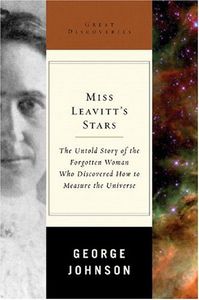"Nearly a century ago, in a cramped room at the Harvard Observatory, a brilliant woman, now almost forgotten, found the key to the vastness of the universe." "Her name was Henrietta Swan Leavitt, and in the days when women were barred from scientific careers she was what was known as a "computer" - a human number cruncher, hired to calculate the positions and luminosities of stars in astronomical photographs. Fighting ill health and progressive hearing loss, straining over nearly indistinguishable specks on photographic plates, she discovered a new law, one that would transform the field of cosmology." "Because of Leavitt's discovery, astronomers could use a kind of star known as a "variable" - one whose brightness waxes and wanes in a regular cycle - as a cosmic yardstick. Her law was immediately enlisted to settle a question that was then dividing astronomers: how big is the universe? One side argued that the Milky Way galaxy was the extent of the universe. Using Leavitt's law, however, the legendary astronomer Edwin Hubble was able to prove that there were stars - indeed, whole galaxies - beyond the Milky Way, and that the universe, as we know now, is almost unfathomably large." "George Johnson contrasts the magnitude of Leavitt's discovery to the quiet near-obscurity of her short life. Miss Leavitt's Stars is both an account of how we measure the universe and the story of a neglected genius."--BOOK JACKET.
| LoC Classification |
QB807 .J64 2005 |
| LoC Control Number |
2005002823 |
| Dewey |
522.0904 |
| Cover Price |
$13.99 |
| No. of Pages |
162 |
| Height x Width |
8.1
x
5.6
inch |
|
|
|
